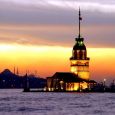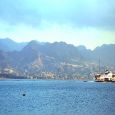Izmit
Advertisement
By Air
Kocaeli neighbours one of the world’s largest metropolitan centers, Istanbul.Its vicinity to Istanbul's two international airports (Sabiha Gokcen International Airport and Ataturk International Airport) which are 45 and 80 km (28 and 50 mi) away, respectively, from Izmit's city center, provides national and international connections.
By Train
Several daily regional expresses connect Izmit with nearby Istanbul.The average price is about TL 5.50/person.You can also book and buy a seat for long distance trains that leave Istanbul’s Asian station for other (Asian) destinations.The cheapest ticket for such a train is TL 3.75/person, the rate for Dogu Express.The journey takes about 2 hours between Istanbul and Izmit by rail.
By Ferry
Being located along the commercially-active Black Sea and Marmara Sea shorelines, Kocaeli boasts 5 ports and 35 industrial docks, making it an important communications center, as well as Anatolia’s farthest inland contact point and a gateway to global markets.The main transportation routes, the D100 highway and the Trans European Motorway which connects Europe with Asia, along with railway lines, form an intercontinental passage network.
By Car
Both highways numbered D100 and O-4/E80 (toll-way) which connect Istanbul and Ankara, two biggest cities of Turkey, pass through or by the city.A drive from Istanbul should take no more than one hour, especially on the O-4/E80 which is of a better quality and avoids towns which D100 traverses all the way along.
Advertisement
Izmit Clock Tower
is one of many clock towers that were built throughout the Ottoman Empire as a result of the decree which was sent to the provincial governors to commemorate the 25th anniversary of Sultan Abdülhamid II's ascension to the Ottoman throne. It was designed by architect Vedat Tek upon the order of Musa Kazım Bey, the governor of Izmit, and built in 1901. Some sources name the architect of the tower as Mihran Azaryan who was an Armenian-Ottoman of Izmit origin.The clock tower has been an inseparable part of the history of Izmit throughout the 20th century, and has become the symbol of the city.The neoclassical clock tower, which stands just in front of the Hünkar Pavilion of Sultan Abdülaziz, has four floors with dimensions 3.65 × 3.65 m (12.0 × 12.0 ft). The ground floor houses fountains, while the clock is on the top floor. All four facades of the middle floors are decorated with the seal of Sultan Abdülhamid II. The pointed cone on top is coated with lead.
Izmir Bird's Paradise
is in the Cigli district is close to the area of Karsiyaka.This is nothing short of a bird watcher's haven and boasts more than 200 different species of birds which are both native and migratory.The park itself covers around 19,770 acres / 8,000 hectares and has remained a protected nature reserve since the early 1990s.Many walking trails are on hand and provide the best vantage points available.
Topkapi Palace
is a palace in Istanbul, Turkey, which was the official and primary residence in the city of the Ottoman Sultans for approximately 400 years (1465-1856) of their 624-year reign.The palace was a setting for state occasions and royal entertainments and is a major tourist attraction today, containing the most holy relics of the Muslim world such as the Prophet Muhammed's cloak and sword.Topkapı Palace is among those monuments belonging to the "Historic Areas of Istanbul", which became a UNESCO World Heritage Site in 1985, and is described in Criterion iv as "the best examples of ensembles of palaces of the Ottoman period."
Aphrodisias
was a small city in Caria, on the southwest coast of Asia Minor.Its site is located near the modern village of Geyre, Turkey about 230 km from Izmir.The city was built near a marble quarry that was extensively exploited in the Hellenistic and Roman periods, and sculpture in marble from Aphrodisias became famous in the Roman world.Many examples of statuary have been unearthed in Aphrodisias, and some representations of the Aphrodite of Aphrodisias also survive from other parts of the Roman world as far afield as Pax Julia in Lusitania.As many pieces of monumental quarried stone were reused in the Late Antique city walls, many inscriptions could and can be easily read without any excavation; the city has therefore been visited and its inscriptions recorded repeatedly in modern times, starting from the early 18th century.The site is in an earthquake zone and has suffered a great deal of damage at various times, especially in severe temblors of the 4th and 7th centuries.An added complication was that one of the 4th century earthquakes altered the water table making parts of the town prone to flooding.Evidence can be seen of emergency plumbing installed to combat this problem.Aphrodisias never fully recovered from the 7th century earthquake, and fell into disrepair. Part of the town was covered by the modern village of Geyre; some of the cottages were removed in the 20th century to reveal the older city.A new Geyre has been built a short distance away.
January - April
October - December
Information not available
Advertisement







